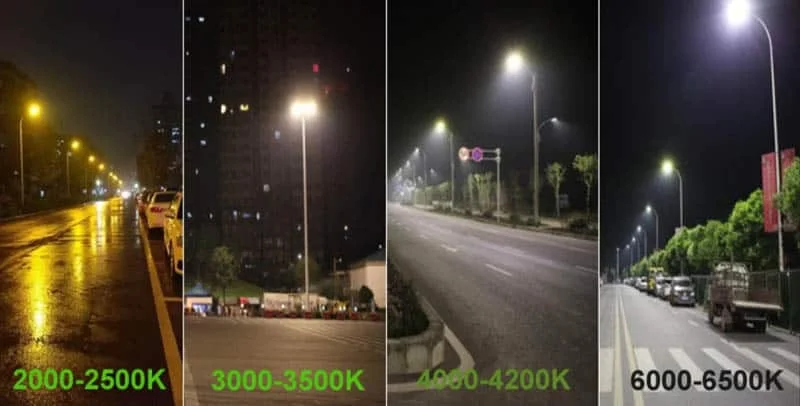Color temperature, measured in Kelvin (K), indicates the appearance of light emitted by a source. This concept originates from the radiation properties of a blackbody radiator. Typically, blackbody temperatures below 4000K emit reddish light, while those above 4000K give off bluish tones, with 7500K appearing distinctly blue.
Typical Color Temperature Range
Most light sources, including solar street lights, fall between 2000K and 6500K.

Kelvin Temperature and Its Effects
- Below 3000K: Produces warm, calm, and inviting light, ideal for residential and commercial indoor spaces.
- Pros: Yellow light penetrates well during rainy days.
- Cons: Reduced visibility in darker environments.
- 3000K to 4500K (Neutral Light): Offers vibrant illumination suitable for workplaces like hospitals and factories.
- Pros: Closest to natural light, provides higher brightness while ensuring safety.
- Cons: Not as visible as higher temperatures above 5000K.
- 4500K to 6500K (Cool White Light): Mimics sunlight and is excellent for areas needing maximum illumination, such as warehouses and safety lighting.
- Pros: High visibility can reduce accidents, particularly above 5700K.
- Cons: May cause fatigue with extended exposure.
LED Solar Street Light CCT Standards
Common color temperature options for LED street lights include:
- 2700K (often labeled as 3000K by some manufacturers)
- 3000K
- 3500K
- 4000K
- 5700K (sometimes referred to as 6000K)
Other custom color temperatures are available as well.

Road Lighting Color Temperature Illumination Ranges
Highway Lighting CCT
Regulations in some countries (such as China) advocate for a color temperature not exceeding 5000K, favoring medium to low temperatures. However, many engineering projects opt for 5700K or higher due to their significant benefits in visibility and accident reduction.
Airport Road Lighting Requirements
Per civil airport standards, LED lights must employ lenses to minimize glare and maintain a color temperature below 4000K.
Residential Area Road Lighting CCT
For mixed traffic areas in residential zones, it’s advisable to use low to medium color temperatures, typically below 4000K.
Rain and Fog Conditions
Lighting along rivers and fog-prone roads should utilize low color temperature lights, ideally between 2700K and 3500K.
Commercial Area Road Lighting CCT
In commercial districts where color recognition for vehicles is crucial, high CRI with low to medium color temperatures is recommended.
Parking Lot Lighting CCT
A Kelvin range of 5700-6500K is optimal, as it enhances focus and driving safety.
Garden and Industrial Lighting Requirements
For outdoor recreational areas, warm colors (2700K-3000K) in spotlights and floodlights are preferable, providing a relaxing ambiance.